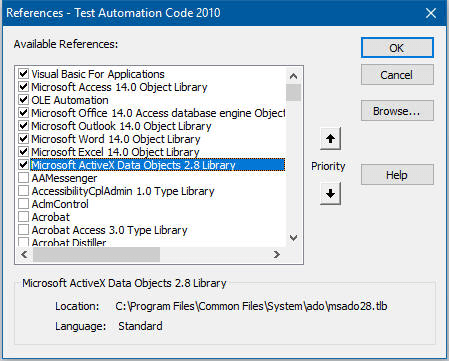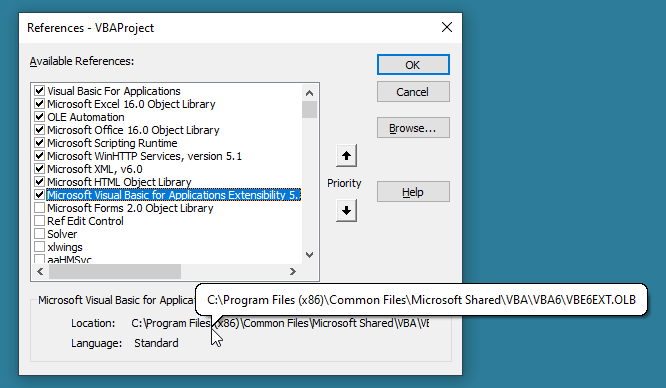The library is a part of office installation, you need to install Microsoft Excel client on your machine. My environment: Excel 2016 - Microsoft Excel 16.0 Object Library. The 15.0 is corresponding to Excel 2013.

- Microsoft Excel 11.0 Object Library is provided by an installation of Excel 2003. If you don’t have Excel 2003 installed on the computer where you are going to run, the library is not available. However, if you have a different version of Excel installed, there will be an Excel nn.0 Object Library available.
- Nov 28, 2014 I just have feelings u dont have that library on ur comp. Download and retype the path w8. Try to refer to 14.0 library after closing program. How to do: Look what I did. I dont have 15.0 library, but I have 14.0. Just go C: Program Files (x86) Microsoft Office over there create new folder whith name 'Office15'.
Excel 15.0 Object Library Download
-->If you use the objects in other applications as part of your Visual Basic application, you may want to establish a reference to the object libraries of those applications. Before you can do that, you must first be sure that the application provides an object library.
To see if an application provides an object library
From the Tools menu, choose References to display the References dialog box.
The References dialog box shows all object libraries registered with the operating system. Scroll through the list for the application whose object library you want to reference. If the application isn't listed, you can use the Browse button to search for object libraries (*.olb and *.tlb) or executable files (*.exe and *.dll on Windows). References whose check boxes are selected are used by your project; those that aren't selected are not used, but can be added.
To add an object library reference to your project
Select the object library reference in the Available References box in the References dialog box and choose OK. Your Visual Basic project now has a reference to the application's object library. If you open the Object Browser (press F2) and select the application's library, it displays the objects provided by the selected object library, as well as each object's methods and properties.
In the Object Browser, you can select a class in the Classes box and select a method or property in the Members box. Use copy and paste to add the syntax to your code.
Excel 14.0 Object Library Download
See also
Support and feedback
Have questions or feedback about Office VBA or this documentation? Please see Office VBA support and feedback for guidance about the ways you can receive support and provide feedback.
-->To develop solutions that use Microsoft Office Excel, you can interact with the objects provided by the Excel object model. This topic introduces the most important objects:
Applies to: The information in this topic applies to document-level projects and VSTO Add-in projects for Excel. For more information, see Features available by Office application and project type.
Note
Interested in developing solutions that extend the Office experience across multiple platforms? Check out the new Office Add-ins model. Office Add-ins have a small footprint compared to VSTO Add-ins and solutions, and you can build them by using almost any web programming technology, such as HTML5, JavaScript, CSS3, and XML.
The object model closely follows the user interface. The Application object represents the entire application, and each Workbook object contains a collection of Worksheet objects. From there, the major abstraction that represents cells is the Range object, which enables you to work with individual cells or groups of cells.
In addition to the Excel object model, Office projects in Visual Studio provide host items and host controls that extend some objects in the Excel object model. Host items and host controls behave like the Excel objects they extend, but they also have additional functionality such as data-binding capabilities and extra events. For more information, see Automate Excel by using extended objects and Host items and host controls overview.

This topic provides a brief overview of the Excel object model. For resources where you can learn more about the entire Excel object model, see Use the Excel object model documentation.
Access objects in an Excel project
When you create a new VSTO Add-in project for Excel, Visual Studio automatically creates a ThisAddIn.vb or ThisAddIn.cs code file. You can access the Application object by using Me.Application or this.Application.
When you create a new document-level project for Excel, you have the option of creating a new Excel Workbook or Excel Template project. Visual Studio automatically creates the following code files in your new Excel project for both workbook and template projects.
| Visual Basic | C# |
|---|---|
| ThisWorkbook.vb | ThisWorkbook.cs |
| Sheet1.vb | Sheet1.cs |
| Sheet2.vb | Sheet2.cs |
| Sheet3.vb | Sheet3.cs |
You can use the Globals class in your project to access ThisWorkbook, Sheet1, Sheet2, or Sheet3 from outside of the respective class. For more information, see Global access to objects in Office projects. The following example calls the PrintPreview method of Sheet1 regardless of whether the code is placed in one of the Sheetn classes or the ThisWorkbook class.
Because the data in an Excel document is highly structured, the object model is hierarchical and straightforward. Excel provides hundreds of objects with which you might want to interact, but you can get a good start on the object model by focusing on a small subset of the available objects. These objects include the following four:
Application
Workbook
Worksheet
Range
Much of the work done with Excel centers around these four objects and their members.
Application object
The Excel Application object represents the Excel application itself. The Application object exposes a great deal of information about the running application, the options applied to that instance, and the current user objects open within the instance.
Note
You should not set the EnableEvents property of the Application object in Excel to false. Setting this property to false prevents Excel from raising any events, including the events of host controls.
Workbook object
The Workbook object represents a single workbook within the Excel application.
The Office development tools in Visual Studio extend the Workbook object by providing the Workbook type. This type gives you access to all features of a Workbook object. For more information, see Workbook host item.
Worksheet object
The Worksheet object is a member of the Worksheets collection. Many of the properties, methods, and events of the Worksheet are identical or similar to members provided by the Application or Workbook objects.
Excel provides a Sheets collection as a property of a Workbook object. Each member of the Sheets collection is either a Worksheet or a Chart object.
The Office development tools in Visual Studio extend the Worksheet object by providing the Worksheet type. This type gives you access to all features of a Worksheet object, as well as new features such as the ability to host managed controls and handle new events. For more information, see Worksheet host item.
Excel 16.0 Object Library
Range object
The Range object is the object you will use most within your Excel applications. Before you can manipulate any region within Excel, you must express it as a Range object and work with methods and properties of that range. A Range object represents a cell, a row, a column, a selection of cells that contains one or more blocks of cells, which might or might not be contiguous, or even a group of cells on multiple sheets.
Visual Studio extends the Range object by providing the NamedRange and XmlMappedRange types. These types have most of the same features as a Range object, as well as new features such as the data binding capability and new events. For more information, see NamedRange control and XmlMappedRange control.
Add Microsoft Excel 15.0 Object Library
Use the Excel object model documentation
For complete information about the Excel object model, you can refer to the Excel primary interop assembly (PIA) reference and the VBA object model reference.
Primary interop assembly reference
The Excel PIA reference documentation describes the types in the primary interop assembly for Excel. This documentation is available from the following location: Excel 2010 primary interop assembly reference.
For more information about the design of the Excel PIA, such as the differences between classes and interfaces in the PIA and how events in the PIA are implemented, see Overview of classes and interfaces in the Office primary interop assemblies.
Microsoft Word 15.0 Object Library
VBA object model reference
The VBA object model reference documents the Excel object model as it is exposed to Visual Basic for Applications (VBA) code. For more information, see Excel 2010 object model reference.
All of the objects and members in the VBA object model reference correspond to types and members in the Excel PIA. For example, the Worksheet object in the VBA object model reference corresponds to the Worksheet object in the Excel PIA. Although the VBA object model reference provides code examples for most properties, methods, and events, you must translate the VBA code in this reference to Visual Basic or Visual C# if you want to use them in an Excel project that you create by using Visual Studio.
Install Microsoft Excel 15.0 Object Library 5 0 Object Library Download
Related topics
| Title | Description |
|---|---|
| Excel solutions | Explains how you can create document-level customizations and VSTO Add-ins for Microsoft Office Excel. |
| Work with ranges | Provides examples that show how to perform common tasks with ranges. |
| Work with worksheets | Provides examples that show how to perform common tasks with worksheets. |
| Work with workbooks | Provides examples that show how to perform common tasks with workbooks. |